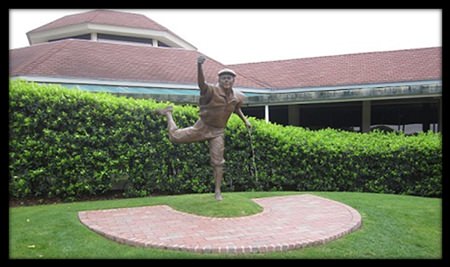By the time this column is published, players in this year’s second major will have completed their first round. This is the 114th staging of what is normally golf’s toughest major – an event where a score of even-par usually wins.
This will be the third US Open played at Pinehurst’s No 2 Course, in Pinehurst, North Carolina. The Donald Ross designed course, opened in 1907, has also hosted the PGA Championship in 1936 and the Ryder Cup in 1951. Its two US Open Champions were Payne Stewart in 1999 and Michael Campbell in 2005.
 Payne Stewart’s memorable reaction on sinking that putt in 1999 – caught in bronze and put on permanent display at Pinehurst No 2.
Payne Stewart’s memorable reaction on sinking that putt in 1999 – caught in bronze and put on permanent display at Pinehurst No 2.
This event, the one major run by the US Golf Association, is its flagship tournament. In determining their host venues, the USGA issue guidelines to courses wishing to be considered for hosting rights. Those guidelines include the intention that the 72-hole winning score should be around par. Whilst course length has become increasingly important, it is far from the only consideration. Hosting venues will be told how narrow their fairways need be, how high and thick the two grades of rough, how difficult the pin placements and so on.
This can be challenging for green-keepers to get right, but on the whole it seems to work. This is the reason that many golf pundits claim the US Open is the toughest major to win. Whether the world’s toughest major is the US Open, or the Open championship at Carnoustie on a howling day, is neither here nor there. What cannot be disputed is that the winning scores in six of the last nine US Opens have been even-par or higher. No other major, particularly in the last decade, comes close in terms of average winning scores close to par.
This can lead to criticism. On the one hand I personally enjoy watching the best players in the world apply their craft, and then walk off the course saying something along the lines of, “I played well today. I shot par.”
On the other, one shot that can go missing at US Opens is the recovery shot. Imagine rough so thick that the only option is to hack the ball out with a sand wedge, some 30-odd yards back onto the fairway. Compare that shot to the one that can and does tempt the player to go for the green, where a great shot will be rewarded, but an average to poor one will be further penalised. The point is the former takes little skill, and is in effect a skill-equaliser. The latter separates the best from the others.
USGA Chief Executive, Mike Davis, who is hands-on with green-keepers in setting the course for the day’s play at US Opens, appears to be aware of this. Pinehurst will, apparently, do away with the penal rough normally associated with US Opens to encourage players to attempt recovery shots more than has been the case in the past. Good.
About half of Pinehurst No 2 greens are shaped liked inverted saucers – they can repel balls. These greens have little or no rough to prevent balls from rolling off greens, down closely-mowed slopes, to finish some 30-odd yards away. Sort of like Pattaya’s Siam Old Course with domed greens. Players will need their scrambling game to be at its best.
Past champions expected in the field include: Justin Rose – England – 2013, Webb Simpson –United States – 2012, Rory McIlroy – Northern Ireland – 2011, Graeme McDowell – Northern Ireland – 2010, Lucas Glover – United States – 2009, Angel Cabrera – Argentina – 2007, Geoff Ogilvy – Australia – 2006, Retief Goosen – South Africa – 2001, 2004, Jim Furyk – United States – 2003, Ernie Els – South Africa – 1994, 1997.
Two past champions who retain exempt status (winners in past ten years), Tiger Woods and Michael Campbell, have pulled out due to lack of fitness.
My ten best bets, with odds courtesy of Paddy Power (as quoted on Friday 6 June) are:
- Rory McIlroy; signs are good, consistency returning – 10/1
- Adam Scott; with the swing he’s got, but that putter – 12/1
- Phil Mickelson; just this one left for a career grand slam – 16/1
- Matt Kuchar; is due a major. Top five scrambler on tour – 25/1
- Justin Rose; Forget missed cut at Memorial, his game is good – 25/1
- Luke Donald; consistent US Open performer. Form good – 28/1
- Jim Furyk; Grafter of all grafters. Leads Tour in scrambling – 33/1
- Steve Stricker; Likes US Open set-ups. Great putter, good odds – 50/1
- Billy Horschel; Rookie with great swing who did well last year – 100/1
- Angel Cabrera; The Man when it comes to touch. Past champion – 125/1
The sentimental favourite has to be Phil Mickelson. What a story that would be if the six-time runner-up could finally win a US Open, and in so doing complete a career grand slam.
Golfnutter




